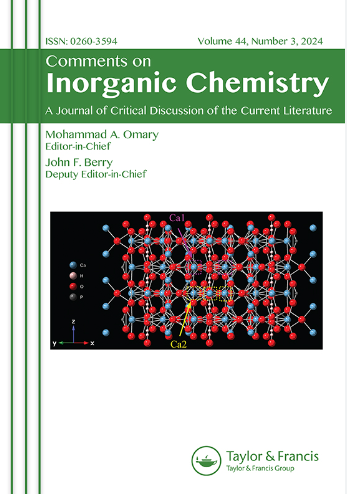基于碱土、主基团和过渡金属的多功能MOFs设计与合成的多主题羧酸酯
IF 3.8
3区 化学
Q1 CHEMISTRY, INORGANIC & NUCLEAR
引用次数: 1
摘要
金属有机骨架(mof)是由金属离子/金属团簇通过有机连接剂/桥接配体协调而成的,已成为一类广泛的晶体杂化材料,具有超高孔隙率和巨大的内表面积。mof具有的几个特点之一是其拓扑多样性和美观的框架结构,可以通过最先进的技术、分子模拟、不同的几何形状和连接到相应金属簇的连接来调整和调整。在这篇重要的综述中,我们打算通过提供从拓扑分析和分子模拟到不同合成路线的各种范围来强调基于羧酸盐的mof的范围。此外,本文还对羧酸mof的网状化学性质和合成后修饰(PSM)的重要性进行了深入研究,为在这些mof中引入官能团提供了另一种途径。我们还试图找出可能存在的漏洞,这些漏洞可以为年轻的研究人员提供广泛的机会,从而在新型mof领域进行详细的探索。本文章由计算机程序翻译,如有差异,请以英文原文为准。
Multi-topic Carboxylates as Versatile Building Blocks for the Design and Synthesis of Multifunctional MOFs Based on Alkaline Earth, Main Group and Transition Metals
ABSTRACT Metal Organic Frameworks (MOFs), built from metal ions/clusters coordinated by organic linkers/bridging ligands, have emerged as an extensive class of crystalline hybrid materials with exceptional ultrahigh porosity and enormous internal surface areas. Out of several hallmarks possessed by MOFs, one is their topologically diverse and aesthetically pleasing framework structures which can be adjusted and tuned with the state-of-art techniques, and molecular simulations, different geometry, and connectivity of a linker to the respective metal cluster. In this critical review, we intend to highlight the scope of carboxylate-based MOFs by providing a varied range from their topology analysis and molecular simulations to different synthetic routes. Moreover, providing insights to reticular chemistry of carboxylate MOFs and the importance of Post-Synthetic Modification (PSM), an alternative route to introduce functional groups within these MOFs. We have also tried to identify the possible loopholes that can provide an extensive opportunity to young researchers that can lead to a detailed exploration in the field of novel MOFs.
求助全文
通过发布文献求助,成功后即可免费获取论文全文。
去求助
来源期刊

Comments on Inorganic Chemistry
化学-无机化学与核化学
CiteScore
9.00
自引率
1.90%
发文量
18
审稿时长
>12 weeks
期刊介绍:
Comments on Inorganic Chemistry is intended as a vehicle for authoritatively written critical discussions of inorganic chemistry research. We publish focused articles of any length that critique or comment upon new concepts, or which introduce new interpretations or developments of long-standing concepts. “Comments” may contain critical discussions of previously published work, or original research that critiques existing concepts or introduces novel concepts.
Through the medium of “comments,” the Editors encourage authors in any area of inorganic chemistry - synthesis, structure, spectroscopy, kinetics and mechanisms, theory - to write about their interests in a manner that is both personal and pedagogical. Comments is an excellent platform for younger inorganic chemists whose research is not yet widely known to describe their work, and add to the spectrum of Comments’ author profiles, which includes many well-established inorganic chemists.
 求助内容:
求助内容: 应助结果提醒方式:
应助结果提醒方式:


